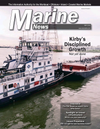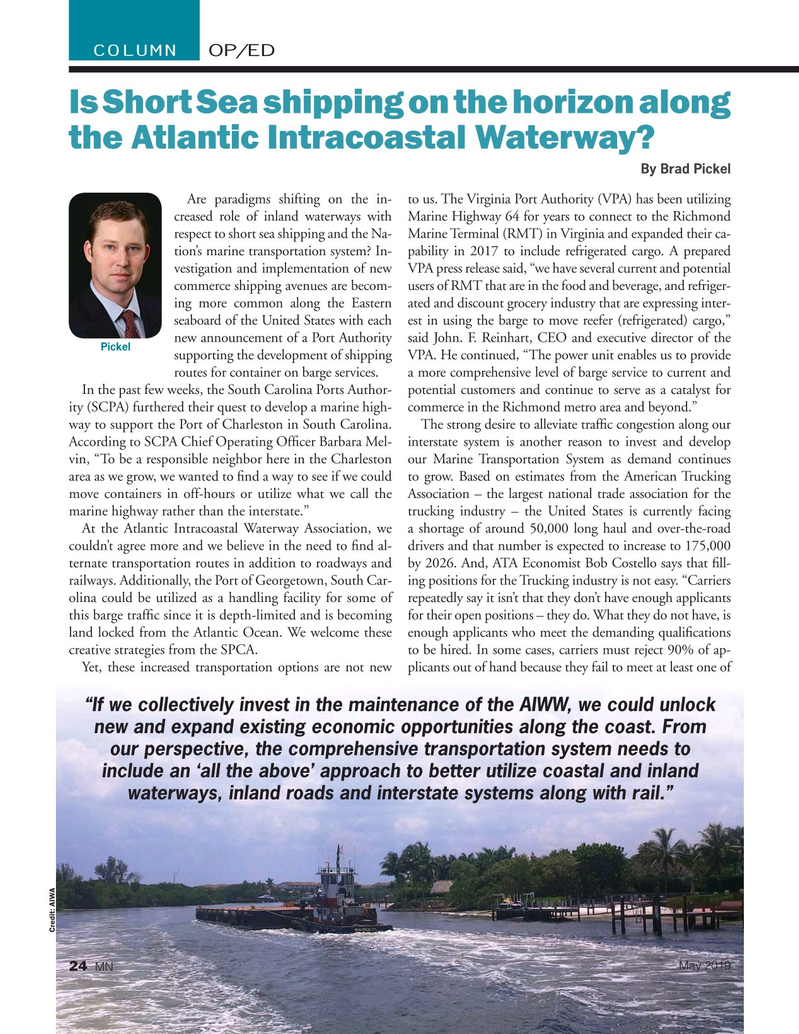
Page 24: of Marine News Magazine (May 2019)
Inland Waterways
Read this page in Pdf, Flash or Html5 edition of May 2019 Marine News Magazine
COLUMN OP/ED
Is Short Sea shipping on the horizon along the Atlantic Intracoastal Waterway?
By Brad Pickel
Are paradigms shifting on the in- to us. The Virginia Port Authority (VPA) has been utilizing creased role of inland waterways with Marine Highway 64 for years to connect to the Richmond respect to short sea shipping and the Na- Marine Terminal (RMT) in Virginia and expanded their ca- tion’s marine transportation system? In- pability in 2017 to include refrigerated cargo. A prepared vestigation and implementation of new VPA press release said, “we have several current and potential commerce shipping avenues are becom- users of RMT that are in the food and beverage, and refriger- ing more common along the Eastern ated and discount grocery industry that are expressing inter- seaboard of the United States with each est in using the barge to move reefer (refrigerated) cargo,” new announcement of a Port Authority said John. F. Reinhart, CEO and executive director of the
Pickel supporting the development of shipping VPA. He continued, “The power unit enables us to provide routes for container on barge services. a more comprehensive level of barge service to current and
In the past few weeks, the South Carolina Ports Author- potential customers and continue to serve as a catalyst for ity (SCPA) furthered their quest to develop a marine high- commerce in the Richmond metro area and beyond.” way to support the Port of Charleston in South Carolina. The strong desire to alleviate traf? c congestion along our
According to SCPA Chief Operating Of? cer Barbara Mel- interstate system is another reason to invest and develop vin, “To be a responsible neighbor here in the Charleston our Marine Transportation System as demand continues area as we grow, we wanted to ? nd a way to see if we could to grow. Based on estimates from the American Trucking move containers in off-hours or utilize what we call the Association – the largest national trade association for the marine highway rather than the interstate.” trucking industry – the United States is currently facing
At the Atlantic Intracoastal Waterway Association, we a shortage of around 50,000 long haul and over-the-road couldn’t agree more and we believe in the need to ? nd al- drivers and that number is expected to increase to 175,000 ternate transportation routes in addition to roadways and by 2026. And, ATA Economist Bob Costello says that ? ll- railways. Additionally, the Port of Georgetown, South Car- ing positions for the Trucking industry is not easy. “Carriers olina could be utilized as a handling facility for some of repeatedly say it isn’t that they don’t have enough applicants this barge traf? c since it is depth-limited and is becoming for their open positions – they do. What they do not have, is land locked from the Atlantic Ocean. We welcome these enough applicants who meet the demanding quali? cations creative strategies from the SPCA. to be hired. In some cases, carriers must reject 90% of ap-
Yet, these increased transportation options are not new plicants out of hand because they fail to meet at least one of “If we collectively invest in the maintenance of the AIWW, we could unlock new and expand existing economic opportunities along the coast. From our perspective, the comprehensive transportation system needs to include an ‘all the above’ approach to better utilize coastal and inland waterways, inland roads and interstate systems along with rail.”
Credit: AIWA
May 2019 24 MN

 23
23

 25
25
